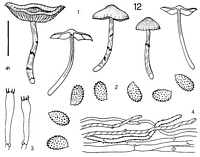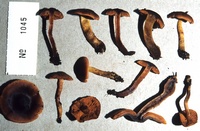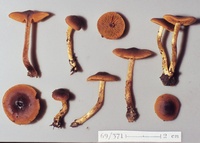|
 Dermocybe largofulgens Dermocybe largofulgens
BiostatusPresent in region - Indigenous. Endemic
Images (click to enlarge)
Caption: Dermocybe largofulgens: 1. carpophores. - 2. spores. - 3. basidia. - 4. pileipellis. | 
Caption: ZT1045
Owner: E. Horak: © Creative Commons Attribution-Noncommercial 3.0 New Zealand | 
Caption: ZT69-371 , Holotype
Owner: E. Horak: © Creative Commons Attribution-Noncommercial 3.0 New Zealand |
Article: Horak, E. (1988) [1987]. New species of Dermocybe (Agaricales) from New Zealand. Sydowia 40: 81-112.
Description: Pileus -40 mm, convex to conico-convex becoming broadly umbonate-expanded to campanulate; dark brown to umber brown, orange to yellow-brown near margin, olive tints absent; viscid when moist, innately fibrillose or smooth in dry conditions, hygrophanous and striate near margin with fibrillose orange veil remnants. - Lamellae 15-22, 3-15, adnate to emarginate ventricose, -3.5 mm wide; brilliant orange to saffron, with ferruginous tinge in mature specimens, edges concolorous, entire. - Stipe -50 x -5 mm, cylindrical occasionally subfusoid or gradually tapering at base, single or cespitose; yellow to orange, below the ± distinct cortina with several mostly inconspicuous appressed concolorous veil zones, dry, fibrillose, hollow. - Context orange-brown. - Odour and taste not distinctive or faintly raphanoid. - Chemical reactions on pileus: KOH - red-brown.
Spore print rust brown. - Spores 5.5-6.5 x 3.5-4 µm, ovoid, verrucose, rust brown. - Basidia 20-28 x 5-6 µm, 4-spored. - Cheilocystidia inconspicuous, scattered clavate cells (15-20 x -10 µm) forming a ± sterile gill edge, hyaline or with red-brown plasmatic pigment. - Pileipellis an ixocutis of strongly gelatinized hyphae (3-8 µm diam.), with (red-)brown to purple plasmatic (rarely also encrusting) pigment readily dissolving in KOH. - Clamp connections present.
Habitat: On soil under Leptospermum spp. mixed with Knightia, Phyllocladus and Agathis. - New Zealand.
Notes: The colours on the carpophores of D. largofulgens are composed of 12 individual pigments (KELLER et al., 1988). Out of these endocrocin is the only compound positively detected whereas the identity of the other 11 pigments still remains unknown. Microscopically D. largofulgens is well characterized by its small verrucose spores which actually are the smallest in all Dermocybe hitherto reported from New Zealand.
The ecological data taken from the two recorded localities in North Island suggest that D. largofulgens must be considered an obligate ectomycorrhizal partner of Leptospermum spp.
|